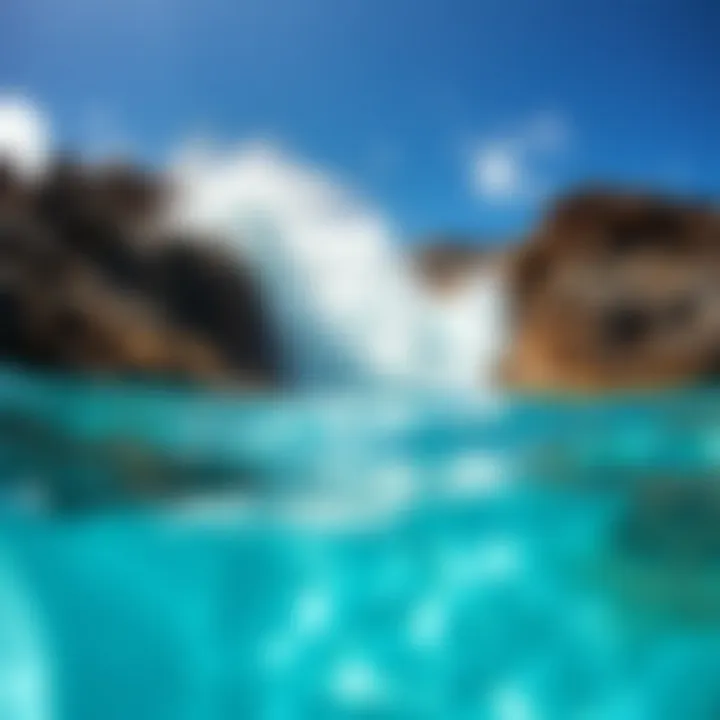Ensuring Safe Drinking Water in Aruba: A Complete Guide


Intro
When it comes to a tropical paradise like Aruba, the captivating beaches and warm sun draw travelers from all corners of the globe. However, amidst the allure lies an important topic that often doesn't get the spotlight it deserves: the safety of drinking water. As a traveler or a local, understanding where your water comes from and how it's treated can impact not just your health but also your overall experience on the island.
Aruba relies heavily on an intricate network of desalination plants and water treatment facilities to provide its residents and visitors with quality drinking water. Yet, with environmental factors and human activities, potential contaminants could pose a threat. This is where regulations come into play—ensuring that water is regularly tested and treated to meet safety standards.
While sipping a cold bottle of water on the beach may seem like a no-fuss affair, it's essential to know how to stay hydrated safely while enjoying your time in Aruba. We will delve deeper into the nuances of drinking water in Aruba, its treatment processes, the significance of regulations, and how you can ensure your hydration is worry-free. Let's dive into the sparkling waters of this topic and emerge with a deeper understanding of what it means to have safe drinking water in paradise.
Foreword to Water in Aruba
Examining the safety of drinking water in Aruba is not just a matter of health; it's about understanding a vital resource that sustains life, especially in an island environment. Water is a finite asset, shaped by geological, environmental, and human factors. Therefore, an adequate grasp of its availability and quality trends can inform residents, tourists, and stakeholders alike about sustainable practices and precautionary measures.
In Aruba, the unique geographical context and climatic conditions demand a closer look. This territory experiences a warm, arid climate that significantly affects water supply. It's imperative for the local community and visitors to comprehend the strategies and technologies implemented to ensure drinking water safety.
Let's break this down into significant aspects:
- Geographical Context: Understanding where Aruba is situated helps visualize the sources of its water.
- Water Availability Challenges: Recognizing the issues that arise due to limited natural freshwater bodies and how they shape water management in Aruba is critical.
Therefore, this segment will lay the groundwork for the rest of the article, highlighting the significance of water safety in Aruba’s distinct setting.
Geographical Context
Aruba is a small island located in the southern Caribbean, near the coast of Venezuela. Despite its tropical climate, it holds a paradox—its geographical layout limits the availability of fresh water. The island is primarily composed of limestone which, while it allows for the formation of aquifers, does not host substantial natural rivers or lakes that one might typically find in other regions. The terrain is largely flat with some hilly areas that do not contribute significantly to freshwater accumulation.
This means the residents and visitors rely heavily on alternative sources of water supply, primarily desalination. The turquoise hues of the sea may be inviting, but it is essential to note that the island lacks immediate access to freshwater sources.
Water Availability Challenges
The challenges surrounding water availability in Aruba are many. With limited natural resources, the island faces ongoing issues that underscore the significance of effective water management strategies. The following points elaborate on these challenges:
- Limited Freshwater: With few aquifers recharge rates, the volume of freshwater is insufficient to meet the demands of the local population, particularly during peak tourist seasons.
- High Demand: The influx of tourists increases the stress on water resources, demanding more from the existing systems.
- Climate Factors: Seasonal droughts and changing weather patterns add more strain to water supply systems. \n Given these challenges, it’s crucial for both the community and visitors to be informed about how water resources are managed and what practices are being used to ensure safety and availability. Understanding the geographical context, alongside the systemic issues of water scarcity, provides a critical lens through which we can assess the drinkability of water in Aruba.
Sources of Drinking Water
Understanding the sources of drinking water in Aruba is fundamental to grasping the overall safety and quality of water available on the island. Given its geographical positioning, the importance of reliable water sources cannot be understated. This section dives into the two primary sources: desalination and natural water bodies, each having distinct characteristics, processes, and implications for water quality.
Desalination Process
In Aruba, desalination is a crucial process that transforms seawater into potable water, taking the center stage in the island's approach to overcoming its natural water scarcity. With around 70% of the island's drinking water derived from this method, understanding its intricacies sheds light on the sustainability of Aruba’s water supply.
Desalination involves several steps, critical for ensuring the water meets safety standards:
- Pre-treatment: This initial stage filters out large particles and contaminants like sand and algae, making the seawater suitable for further processing.
- Reverse Osmosis: This is the heart of the desalination process. Through a semi-permeable membrane, water is forced under high pressure, allowing only pure water molecules to pass, while salts and impurities are left behind.
- Post-treatment: The treated water undergoes remineralization and disinfection. Minerals like calcium are added back to the water, improving taste and providing essential nutrients.
The desalination facilities in Aruba, such as the Water en Energie Bedrijf Aruba, operate under stringent regulations, ensuring both efficiency and safety. However, while this process offers a steady supply of drinking water, there are considerable energy and infrastructure costs associated with desalination.
"Water sourced from desalination is efficient but needs constant monitoring to ensure it remains a safe option for residents and visitors alike."
Natural Water Sources
Though desalination dominates, Aruba does have some natural water sources, albeit limited. Rainwater harvesting, especially during the wet season from October to December, provides an alternative supply. The island typically receives around 20 inches of rain annually, which might not seem like much, but it is adequate for collection systems designed to store and filter water.
Natural springs surface in few locations across the island, contributing to the existing supply but are insubstantial compared to the volumes provided by desalination.


Here are some considerations regarding natural sources:
- Seasonal Variability: Rainfall varies significantly, which can lead to inconsistencies in water availability.
- Contamination Risks: Natural sources can easily be affected by environmental factors, such as pollutants from nearby urban developments or agricultural runoff, making consistent quality checks essential.
- Cultural Practices: Some local communities engage in traditional methods of rainwater collection, reflecting cultural values surrounding water usage and sustainability.
Water Quality Treatment Methods
Ensuring the safety of drinking water is crucial, especially in a tropical location like Aruba. The process of treating water involves several methods aimed at removing contaminants and making water safe for consumption. These methods can significantly influence overall water quality and public health. Understanding water quality treatment methods is important not just for residents but also for visitors who participate in water sports or outdoor activities. In this section, we’ll delve into specific treatment techniques, highlighting their advantages, limitations, and considerations.
Filtration Techniques
Filtration is one of the key steps in the process of water treatment. This method helps in physically removing particulates from water, such as sand, silt, and microorganisms. Filtration techniques vary widely in sophistication, from simple sand filters to advanced membrane filtration systems.
Types of Filtration
- Sand Filters: Traditional and often used in household settings. They effectively remove larger particles and some microorganisms.
- Activated Carbon Filters: Ideal for removing chlorine taste and odor, making them popular in many urban households.
- Reverse Osmosis Systems: These remove a broad range of contaminants, including heavy metals and other dissolved solids. It is a highly effective method, though it can be costly and requires regular maintenance.
This process not only enhances the aesthetic quality of water, making it more palatable but also substantially reduces health risks associated with contaminated water. However, filtration systems must be regularly monitored and maintained to ensure they function efficiently and do not become a source of contamination themselves.
Chlorination and Disinfection
Following the filtration process, chlorination plays a vital role in disinfecting water. Chlorination is the addition of chlorine to water to kill harmful bacteria, viruses, and other pathogens that filtration alone might miss. This is particularly important in areas where the risk of microbial contamination is high.
The Importance of Chlorination
- Effectiveness: Chlorine is highly effective in eliminating a range of harmful microorganisms, securing public health.
- Residual Protection: Chlorination provides residual protection, meaning that even after treatment, bacteria that enter the distribution system can be controlled.
- Cost-Effective: It is a relatively low-cost method for disinfection compared to other technologies.
However, while chlorination is beneficial, there are concerns regarding by-products formed when chlorine reacts with organic matter. Compounds like trihalomethanes (THMs) could pose health risks if present in high concentrations. Therefore, careful management is needed to balance effectiveness and safety.
"The balance of water treatment methods, from filtration to disinfection, is paramount in ensuring water quality that meets public health standards."
Potential Contaminants of Concern
Understanding potential contaminants in drinking water is essential for ensuring the health of both residents and visitors in Aruba. As we navigate an environment filled with various sources of water, from the ocean and groundwater to man-made systems, acknowledging what might compromise water quality becomes crucial. Contaminants can undermine the confidence of kiteboarders and other water enthusiasts who rely heavily on drinking water for hydration, especially when engaging in physically demanding activities.
Microbial Contaminants
Microbial contaminants refer to bacteria, viruses, and protozoa that can find their way into the water supply. Their presence poses significant health risks, contributing to waterborne illnesses which can cause symptoms like diarrhea, vomiting, and dehydration. In Aruba, these contaminants may originate from improperly treated wastewater or runoff from heavy rains, especially during the rainy season.
One notable concern is Escherichia coli, or E. coli, which is often used as an indicator of fecal contamination. The presence of E. coli can suggest that harmful pathogens might be lurking in the water. For the adventurous kiteboarder, the last thing you want is to catch a stomach bug from water that looked inviting after a long session on the waves. Proper sanitation measures and regular monitoring of water quality are essential in mitigating these risks.
It's important to be aware that even in tourist-friendly areas, local water quality can be influenced by agricultural runoff or sewage discharge, thus impacting beach and drinking water safety. Continuous community education on hygiene and regular health inspections of water sources can help in minimizing these threats.
Chemical Contaminants
Chemical contaminants encompass a broad range of substances, from heavy metals like lead and mercury to synthetic compounds such as pesticides and pharmaceuticals. These contaminants can infiltrate the water through various means, including industrial discharges and agricultural practices.
In Aruba, the use of agricultural chemicals raises red flags with the potential of runoff contaminating local water supplies. Moreover, detection of nitrogen and phosphorus from fertilizers can result in algal blooms, which deplete oxygen in the water and lead to further complications for marine ecosystems.
Another class of chemical contaminants includes disinfection byproducts, which can form when chlorine used to kill harmful microorganisms reacts with organic matter in the water. While chlorine is vital in making water safe, ongoing vigilance in balancing effective treatment methods and reducing chemical residues is salient.
Public understanding of these issues is crucial. Awareness campaigns informing both locals and tourists about the potential hazards associated with chemical contaminants can encourage safer practices around water consumption and waste disposal.--
"Healthy water is not only a necessity; for those engaging in extreme sports, it can make or break your experience."


In summary, microbials and chemicals represent threats to water safety in Aruba. Adequate monitoring, educational initiatives, and robust regulatory frameworks play an integral role in safeguarding drinking water and maintaining public health. Ensuring clean, safe water not only benefits the local population but also enhances the experience for water sports enthusiasts, making every session enjoyable and worry-free.
Regulatory Standards and Oversight
The safety of drinking water in Aruba is heavily influenced by the regulatory frameworks established by the government. These regulations ensure that water quality remains high and that residents and visitors can trust the potable water supplied to them. Without proper oversight, the risks associated with drinking water contamination could rise dramatically, impacting public health and overall trust in local water resources.
Government Regulations
In Aruba, the authority to regulate drinking water falls under the Minister of Health. The government has hot a clear set of regulations that align with international standards, ensuring that local water quality meets certain thresholds. These regulations cover various aspects of water safety, including:
- Water Quality Standards: These define the acceptable levels of various contaminants in drinking water. These parameters are critical, as they help to protect against harmful substances that could lead to health issues.
- Testing Requirements: Regulations stipulate regular testing of water sources, including both chemical and biological assessments. These tests help detect potential contamination early on, preventing larger health crises.
- Treatment Processes: The government mandates that water treatment facilities follow specific protocols to ensure that the water is effectively purified before it reaches consumers.
Navigating these regulations is not just a bureaucratic formality; it lays the groundwork for public safety and environmental protection. Compliance with government regulations fosters confidence amongst the community, which is essential in a water-scarce region like Aruba.
Monitoring and Compliance
The effectiveness of water regulations largely hinge on rigorous monitoring and compliance measures. The role of the Aruban government and relevant agencies extends far beyond establishing laws; it involves ongoing vigilance to ensure that these laws are respected and enforced.
Monitoring practices typically include:
- Regular Inspections: Water supply systems undergo systematic inspections, enabling authorities to assess infrastructure integrity and operational practices.
- Public Reporting: There’s an obligation to report water quality to the public regularly, making the information accessible. This transparency is crucial for community awareness and involvement.
- Responding to Incidents: Should contamination be detected, regulations require immediate action. Rapid response protocols are essential to mitigate health risks and restore safe drinking conditions swiftly.
"The safety of drinking water is the cornerstone of a healthy society; without it, we risk not just public health, but the very fabric of community trust."
Engaging in such comprehensive monitoring practices ensures that Arubans can drink their water without fear. For those involved in sports and outdoor activities, especially kiteboarders who are often exposed to the elements, knowing that there are solid standards and monitoring in place can lead to greater peace of mind.
Closure
From setting the foundational regulations to ensuring strict compliance through vigilant monitoring, the oversight of drinking water safety in Aruba is a dynamic process. Tourists and residents alike should feel reassured that local authorities are committed to maintaining the highest standards in water safety, paving the way for a healthier community.
Bottled Water Considerations
When it comes to staying hydrated while exploring the sun-soaked landscapes of Aruba, bottled water becomes a topic of great significance. While the island's municipal water supply is treated and generally deemed safe for consumption, many visitors still prefer the convenience of bottled options. This section delves into the reasons behind this preference and provides insights that can enhance your hydration strategy during your stay.
Market Overview
The bottled water market in Aruba is thriving, reflecting a broader global trend towards pre-packaged beverages. Tourists often find a wide assortment of bottled water brands on offer, ranging from locally sourced varieties to internationally recognized names. Some visitors may be surprised to find that even in a place known for its desert-like climate, the choices available are plentiful.
- Local Brands: Many Aruba residents favor local brands that source water directly from the island. These products not only support local business but also reflect the unique mineral content found in the area.
- Imported Brands: Names like Evian or Fiji can also be found, providing tourists a sense of familiarity.
- Convenience Stores and Supermarkets: Almost every corner of the island hosts stores where these bottled options can be snagged easily, ensuring that hydration is just a quick trip away.
While bottled water may be more expensive than tapping into the treated tap supply, many find peace of mind in knowing they have a reliable option at hand.
Best Brands for Tourists
When navigating the array of water bottles on Aruba's shelves, a few brands stand out as particularly noteworthy for their quality and popularity among both locals and tourists.
- Alto Vista: Well-loved for its crisp taste, this local brand is bottled right from natural springs. Its balance of minerals is a favorite among health-conscious visitors.
- Riviera: Another local favorite, Riviera emerges as a highly regarded option for a refreshing, clean taste that can quench the thirst of adventurous souls.
- Viva: This imported brand is well-known in many countries and offers the smoothness and reliability for tourists who may prioritize familiarity over local flavors.
While these brands hold a reputation for quality, it's crucial to stay mindful of where and how you purchase bottled water. Buying from reputable stores or established supermarkets can help ensure the water is fresh and beverages are stored properly.
"In Aruba, the water flows to meet the needs of the thirsty, just like the island’s spirit finds ways to uplift its visitors."
Having this blend of local and international options enhances the sense of choice for travelers, allowing them to select products that suit their personal taste while enjoying the island's lush experiences.
Considering whether to reach for bottled water or opt for tap can be influenced by a mix of taste, convenience, and awareness of local practices. With ample choices available in Aruba, visitors can satisfy their hydration needs with confidence.


Hydration Tips for Visitors
When it comes to staying hydrated in Aruba, there’s more than meets the eye. The tropical climate can be both a blessing and a curse for those not accustomed to high temperatures and humidity. Knowing how to choose safe drinking water and recognizing the signs of contamination can make all the difference. Here are essential tips to ensure you stay refreshed and healthy during your stay.
Choosing Safe Drinking Water
Choosing safe drinking water in Aruba is paramount, especially for travelers partaking in various water sports like kiteboarding. The island’s water supply primarily comes from desalination, making it essential to understand your options. Travelers have two primary choices: tap water and bottled water.
- Tap Water: When considering tap water, it’s generally considered safe to drink across Aruba due to stringent government regulations. However, always check for any local advisories, particularly after a heavy rainfall which can affect water quality.
- Bottled Water: Bottled water provides a convenient alternative. Popular brands are widely available at supermarkets and convenience stores. Look for well-known labels, ensuring the seal is intact before purchasing.
- Water Purification: If you're camping or staying in areas with less guarantee of water quality, consider carrying a portable water purifier or hydration tablets. Brands like LifeStraw or Aquatabs can filter out contaminants effectively.
Before consuming any water, it is wise to use your judgement. If in doubt, stick to bottled options as a safe fallback. Always ask locals or staff at your accommodation about recommendations.
Recognizing Signs of Contaminated Water
Being able to recognize signs of contaminated water is crucial. Drinking bad water can impact your health, causing gastrointestinal issues that can derail even the best-laid plans. Here are some points to consider:
- Unusual Taste or Smell: If you notice a strange or unpleasant odor, the water may be contaminated.
- Cloudiness or Floating Particles: Water that appears murky or contains visible particles is best avoided. Pure water should be crystal clear.
- Health Symptoms: Be alert for symptoms such as diarrhea, vomiting, or stomach cramps after drinking water. These can be indicators of contamination.
- Local Knowledge: Engage with locals or tour guides about seasonal variations or specific areas to avoid. Locals often have first-hand experiences that can protect you from potential hazards.
"The best defense against illness caused by water is to stay informed and cautious."
Local Perspectives on Water Safety
Understanding the local perspectives concerning water safety in Aruba provides a unique insight into how the community views the quality of drinking water. Insights from individuals who drink this water daily, their experiences, and the cultural attitudes towards water safety shape broader perceptions, helping to ensure quality and safety for both locals and visitors. This section explores two crucial aspects: community awareness programs that foster knowledge about water safety and the prevailing public sentiment about water quality in Aruba.
Community Awareness Programs
Community awareness programs are pivotal in educating residents about the significance of drinking water safety. Such initiatives often focus on several key elements:
- Educational Workshops: These involve engaging citizens through various platforms, including schools, community centers, and local events. Such workshops not only highlight the health risks associated with contaminated water but also explain the merits of using treated or bottled water as alternatives.
- Public Campaigns: Many organizations host campaigns using social media, posters, and local radio advertisements to encourage safe drinking habits. They serve as a reminder of things like boiling water before consumption during specific seasons, where contamination risks might arise.
- Collaboration with Local Governments: When local governments and community organizations work hand in hand, they can create larger outreach programs. Initiatives can include distribution of water testing kits, enabling residents to check for potential contaminants in their water supply.
Such programs have several benefits:
- Empowerment: By providing information, residents feel more in control of their water consumption choices.
- Community Engagement: A strong sense of community often fosters increased volunteerism, with people playing active roles in educating others.
- Increased Trust in Local Water Authorities: When communities are kept informed, they tend to place confidence in their water safety measures.
Involving the local populace in the conversation about water safety enhances overall effectiveness tremendously. Ultimately, community awareness programs represent a linchpin in developing a culture that prioritizes water safety in Aruba.
Public Sentiment on Water Quality
Public sentiment regarding water quality reveals much about the trust locals place in their water supply. There are various opinions, and understanding them can be critical for both visitors and institutions involved in water treatment.
Some of the key sentiment indicators include:
- Trust in Local Authorities: Many residents express confidence in the mechanisms and regulations put in place by the government to safeguard water quality. Still, there are concerns regarding updates or improvements needed in technology, particularly when it comes to desalination processes.
- Health Experiences: Anecdotes of health-related issues are shared within communities, often highlighting personal experiences with water-related illness. These narratives can influence how many perceive the daily draft of their water.
- Comparative Analysis: Locals often compare the safety of the island's water with that of other places they've lived in or visited. This comparative viewpoint can showcase discrepancies in quality and can lead to demand for improved standards.
In summary, public sentiment can serve as both a mirror reflecting the challenges of water quality and as a catalyst for change. When residents feel their voices are heard and their concerns addressed, it leads to greater transparency and pushes for more accountability from water authorities.
End
Evaluating the safety of drinking water in Aruba is not just a concern; it’s a necessity for locals, tourists, and especially for those engaged in activities like kiteboarding. Clean, safe drinking water is crucial for maintaining health and optimal performance in physically demanding sports. Understanding the sources, treatment processes, and potential contaminants helps in making informed choices about hydration.
Final Thoughts on Water Safety in Aruba
In the context of this article, a few key elements stand out:
- Awareness of Water Sources: Knowing where drinking water comes from—be it desalinated seawater or natural aquifers—provides insight into what might be in your glass.
- Treatment Processes: Understanding how water is filtered and disinfected assures consumers that they’re drinking water that has been properly treated.
- Regulatory Standards: Awareness of local regulations and oversight offers reassurance about water quality. It’s important to know how often the water is tested and what standards are in place.
Moreover, keeping an eye on potential contaminants is essential for protective measures. Microbial threats, while often transient, can have serious health implications, particularly in a sport like kiteboarding, where hydration is key.
Be mindful of local perceptions about water safety. Engaging with community programs can provide further insights into the general consensus and experiences of residents and visitors alike.
Ultimately, staying hydrated and ensuring the water you drink is safe is not just a matter of good practice—it's essential for your well-being. So, whether you’re catching waves or enjoying a day at the beach, ensure that your hydration source is reliable and safe.















